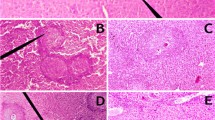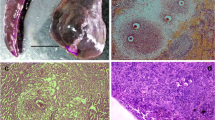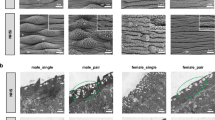Abstract
The aim of this study was to investigate the contribution of the sex of both the parasite and the host to the inflammatory response induced in unisexual infections of Schistosoma mansoni in mice. Organ weight, cell count and the delayed type hypersensitivity reaction were used as tools in this comparative study. The inflammatory reactions differed as a function of the sex of both the host and the parasite. Female mice showed a stronger inflammatory reaction to schistosome infection than males, while male schistosomes induced a stronger inflammatory response compared to females. The host-related differences in the inflammatory reaction may reflect differences in the factors affecting the immune defence of male and female mice. The differences in the inflammatory response induced by the parasite are discussed in terms of the quantity and quality of antigens among male and female worms.



Similar content being viewed by others
References
Attallah AM, Smith AH, Murrell KD, Fleischer A, Woody J, Vannier WE, Scher I, Ahmed A, Sell KW (1979) Characterization of the immunosuppressive state during Schistosoma mansoni infection. J Immunol 122:1413–1420
Baki CA, Guerret S, Grimaud JA, Chevallier M (1998) Liver fibrosis in unisexual murine schistosomiasis: quantitative study and morphological changes in mice with chronic infection. Cell Mol Biol 44:627–633
Bickle Q, Bain J, McGregor A, Doenhoff M (1979) Factors affecting the acquisition of resistance against Schistosoma mansoni in the mouse. III. The failure of primary infections with cercariae of one sex to induce resistance to reinfection. Trans R Soc Trop Med Hyg 73:37–41
Blazkovec AA, Orsini MW (1976) Ontogenic aspects of sexual dimorphism and the primary immune response to sheep erythrocytes in hamsters from prepuberty through senescence. Int Arch Allergy Immunol 50:55–67
Boissier J, Moné H (2000) Experimental observations on the sex ratio of adult Schistosoma mansoni, with comments on the natural male bias. Parasitology 121:379–383
Boissier J, Morand S, Moné H (1999) A review of performance and pathogenicity of male and female Schistosoma mansoni during the life cycle. Parasitology 119:447–454
Davis AH, Blanton R, Kich P (1985) Stage and sex specific differences in actin gene expression in Schistosoma mansoni. Mol Biochem Parasitol 17:289–298
Eloi-Santos S, Olsen NJ, Correa-Oliveira R, Colley DG (1992) Schistosoma mansoni: mortality, pathophysiology, and susceptibility differences in male and female mice. Exp Parasitol 75:168–192
Eppert A, Lewis FA, Grzywacz C, Coura-Filho P, Caldas I, Minchella DJ (2002) Distribution of schistosome infections in molluscan hosts at different levels of parasite prevalence. J Parasitol 88:232–236
Fantappie MR, Galina A, Luis de Mendonca R, Furtado DR, Secor WE, Colley DG, Correa-Oliveira R, Freeman GJ, Tempone AJ, Lannes de Camargo L, Rumjanek DF (1999) Molecular characterisation of a NADH ubiquinone oxidoreductase subunit 5 from Schistosoma mansoni and inhibition of mitochondrial respiratory chain function by testosterone. Mol Cell Biochem 202:149–158
Harrison RA, Bickle Q, Doenhoff MJ (1982) Factors affecting the acquisition of resistance against Schistosoma mansoni in the mouse. Evidence that the mechanisms which mediate resistance during early patent infections may lack immunological specificity. Parasitology 84:93–110
Hoffman KF, Johnston DA, Dunne DW (2002) Identification of Schistosoma mansoni gender-associated gene transcripts by cDNA microarray profiling. Genome Biol 3: research 0041.1–0041.12
Hsu SYL (1969) Sex of schistosome cercariae as a factor in the immunization of rhesus monkeys. Exp Parasitol 25:202–209
Leptak CL, McKerrow JH (1997) Schistosome egg granulomas and hepatic expression of TNF-α are dependent on immune priming during parasite maturation. J Immunol 158:301–307
Lopes JD, Moreira AAB, Campos R, Kanamura HY, Hoshino-Shimizu S, Gayotto LCC, Da Silva LC (1981). Circulating antigens, antibodies and glomerular immune complexes in mice with unisexual Schistosoma mansoni infection. Rev Inst Med Trop Sao Paulo 23:155–160
Mahmoud AAF, Woodruff AW (1978) The causation of splenomegaly in schistosomiasis in mice. Clin Sci Mol Med 54:397–401
Martin JT (2000) Sexual dimorphism in immune function: the role of prenatal exposure to androgens and estrogens. Eur J Pharmacol 405:251–261
Menrath M, Michel A, Kunz W (1995) A female-specific cDNA sequence of Schistosoma mansoni encoding a mucin-like protein that is expressed in the epithelial cells of the reproductive duct. Parasitology 111:477–483
Minchella DJ, Sollenberger KM, Pereira de Souza C (1995) Distribution of schistosome genetic diversity within molluscan intermediate hosts. Parasitology 111:217–220
Moloney NA, Hinchcliffe P, Webbe G (1986) The ability of single sex infections of Schistosoma japonicum to induce resistance to reinfection in mice. J Helminthol 60:250–254
Moné H, Mouahid G, Shaban MA, Al Jabri A, Boissier J, Ruppel A, Idris M (2003) Ecological and molecular studies on emerging schistosomiasis mansoni in Dhofar Governorate, Sultanate of Oman. Trop Med Int Health 8:269–276
Mota-Santos TA, Toledo MIM, Correa MCR, Correa-Oliveira R, Gazzinelli G (1981) Schistosomiasis from S. mansoni in mice: the relationship between acquired immunity and serum levels of lethal antibody. Parasite Immunol 3:319–325
Nakazawa M, Fantappie MR, Freeman GJ, Eloi-Santos S, Olsen NJ, Kovacs WJ, Secor WE, Colley DG (1997) Schistosoma mansoni: susceptibility differences between male and female mice can be mediated by testosterone during early infection. Exp Parasitol 85:233–240
Nash TE (1978) Antibody response to a polysaccharide antigen present in the schistosome gut. Am J Trop Med Hyg 27:938–943
Nelson JL, Steinberg AD (1987) Sex steroids, autoimmunity and autoimmune diseases. In: Berczi I, Kovacs K(eds) Hormones and immunity. MTP Press, The Hague
Noya O, Alarcon de Noya B, Losada S, Colmenares C, Guzman C, Lorenzo MA, Bermudez H (2002) Laboratory diagnosis of schistosomiasis in areas of low transmission: a review of a line of research. Mem Inst Oswaldo Cruz 97:167–169
Ruppel A, Diesfeld HJ, Rother U (1985a) Immunoblot analysis of Schistosoma mansoni antigens with sera of schistosomiasis patients: diagnostic potential of an adult schistosome polypeptide. Clin Exp Immunol 62:499–506
Ruppel A, Diesfeld HJ, Hempelmann E, Janitschke K, Karam M, Breternitz U, Rother U, Burger R (1985b) Schistosoma mansoni: characterization of a protein with diagnostic potential using monospecific patient sera and monoclonal antibodies. Immunobiology 170:76
Silva CLM, Morel N, Lenzi HL, Noel F (1998) Increased reactivity to 5-hydroxytryptamine of portal veins from mice infected with Schistosoma mansoni. Comp Biochem Physiol Part A 120:417–423
Sire C, Durand P, Pointier JP, Théron A (1999) Genetic diversity and recruitment pattern of Schistosoma mansoni in a Biomphalaria glabrata snail population: a field study using random-amplifield polymorphic DNA markers. J Parasitol 83:436–441
Smithers SR (1962) Stimulation of acquired resistance to Schistosoma mansoni in monkeys: role of eggs and worms. Exp Parasitol 12:263–273
Vogel H (1941) Infektionsversuche an verschiedenen Bilharzia-Zwischenwirten mit einen einzelnen Mirazidium von Bilharzia mansoni und B. japonica. Zentralbl Bakteriol 1 Abt Orig B Hyg Krankenhaushyg Betriebshyg Praev Med 148:29–35
Vogel H, Minning W (1953) Über die erworbene resistenz von Macacus rhesus gegenüber Schistosoma japonicum. Z Tropenmed Parasitol 4:418–505
Acknowledgements
This work was supported financially by the UNDP World Bank WHO Special Program for Research and Training in Tropical Diseases, the French Ministère de l'Enseignement Supérieur et de la Recherche, the Centre National de la Recherche Scientifique and the Conseil Régional du Languedoc-Roussillon. The experiments comply with the current laws of France and Germany.
Author information
Authors and Affiliations
Corresponding author
Rights and permissions
About this article
Cite this article
Boissier, J., Chlichlia, K., Digon, Y. et al. Preliminary study on sex-related inflammatory reactions in mice infected with Schistosoma mansoni . Parasitol Res 91, 144–150 (2003). https://doi.org/10.1007/s00436-003-0943-1
Received:
Accepted:
Published:
Issue Date:
DOI: https://doi.org/10.1007/s00436-003-0943-1




